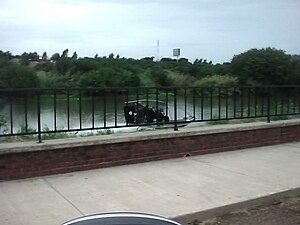The mess on Mexico's southern border
 Image via Wikipedia
Image via WikipediaIf the border that separates the United States and Mexico is fairly easy to penetrate, then Mexico's other border - the southern one, abutting Guatemala - is virtually a sieve.There is more.
For a few pesos, boatmen along this jade-hued jungle river will take people or cargo across, no questions asked. On one recent day, rustlers could be seen driving long-horned cattle from trucks at river's edge onto waiting boats.
That's just garden-variety smuggling. Of greater concern are the tons of illicit narcotics that move north, and the drug cartel gunmen who move easily in either direction, committing crimes on one side only to escape to refuge on the other.
Two weeks ago, assailants thought to be from Los Zetas, a Mexico-based criminal cartel, stormed a ranch in Guatemala's Peten region and killed 27 people, beheading most of them. Guatemala's army raced to cut them off before they could get back across the border, but failed.
The lack of security along Mexico's border with Guatemala is triggering concerns in Central America and as far away as Washington. Authorities now think that three Mexican drug groups have moved into the Peten, where they operate virtually unchallenged. Guatemala's president, Alvaro Colom, is voicing alarm.
"They are invading us," Colom told El Pais, a Madrid daily newspaper, in an interview last week. "And either the countries of Central America join together to fight them or they will defeat us and finish off our democracies."
Worse yet, there's evidence that Los Zetas are using the lack of security on the border to smuggle north deserters from a feared Guatemalan army unit known as the Kaibiles to serve as ground troops and enforcers in Mexico's bloody drug conflict.
U.S. officials think that Mexico is ill-equipped to respond to the situation. Mexico has massed most of its army in the north, near the U.S. border, to counter the narcotics traffickers who've killed thousands there as they battle for lucrative smuggling routes.
"The last thing they want to do is open up another front in the south before they're able to get their arms around the challenges in the northeast," Adm. James Winnefeld Jr., the head of the U.S. Northern Command, the military district that includes Mexico, told the Senate Armed Services Committee last month, referring to Mexico's government.
The Kaibiles began counterinsurgency operations in the 1970s as a civil war gripped Guatemala, and practiced scorched-earth tactics against Mayan villages suspected of harboring insurgents. The Kaibiles slogan is: "If I advance, follow me. If I stop, urge me on. If I retreat, kill me."
A U.S. diplomatic cable obtained by WikiLeaks highlighted how few resources are devoted to policing Mexico's southern border. In the cable, made public last December and written 11 months earlier, a U.S. political counselor wrote that 30,000 U.S. Customs and Border Protection agents keep track of the 1,926 mile U.S.-Mexico border.
But on Mexico's southern frontier, he wrote, "only 125 Mexican immigration officials monitor the 577-mile border with Guatemala. Mexican immigration officials repeatedly confirmed that they do not have the manpower or resources to direct efforts effectively along the southern border."
...
Mexico needs more troops, but finding some it can trust is not an easy task. In some regards the Southern Border is more important for stopping the trafficking. It is much shorter and should be easier to cordon off. The lack of supply would then effect the guys who are trying to control the northern border.
The Kaibiles are a new organization that we will have to keep an eye on. The Zetas have lost a lot of men recently and may need the new recruits to stay viable.

Comments
Post a Comment